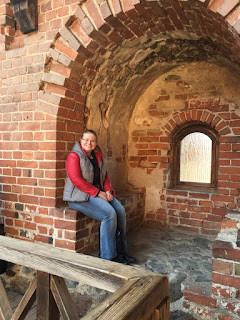The other days I spent further exploring the city. From my hotel I could walk to the city centre (0€), take a bus (1€ per trip or 3.48€ per day) or take an Uber car (1-3€).
On 1st April, I went to the Republic of Uzupis - an artist and handicraft quarter that declared itself a republic with constitution, flag, anthem, army (less than 20 people) and government. April Fools' Day was their Independence Day and for this they stopped everybody going into the quarter andgave them a stamp. A concert was staged on the Angel square. Basically, do not take them too serious - they would not do so themselves.
As I already had bought an entrance ticket to the Bell Tower and Church Heritage Museum together the Crypts (10€ instead of 3x 4.50€). I visited first the Bell Tower that had several levels (reception & ticket office, exhibition area and CCTV station where you can zoom into predefined views of landmarks orjust stalk people on the street). The view after climbing all the stairs that followed was great on Gediminas Street (the main shopping street), the cathedral square and the surrounding areas. The skyline was dominated by the 44 churches (that's the number I was told).
The Church Heritage Museum showcased the treasury of the cathedral and other churches and had an exhibition of wooden statues carved by a priest in the beginning of the 20th century.
Another interesting pick was the Money Museum -that explained the usage and history of money from the early beginnings tothe Euro and plastic cards of today. Exhibits included old coins, bank notes from all over the world and a money pyamid of Lietas coins. Lithuania changed to the Euro in 2014.
In between, I went up to the castle hill (wear flats - the cobblestones were already not easy to cope with in these shoes). If you approach from the other side, you can cut part of the climb with the funicular (1€). There were only ruins of the castle left - the Watch Tower had been restaurated and displayed different historic items.
One room was dedicated to the Baltic Way - on 23rd August 1989 people from all three Baltic States (then still Soviet Republics) formed a human chain from thetower over highways, bridges and borders to Riga (the capital of Latvia) and Talinn (the capital of Estonia) in their strive for independence. In 1990, all of them became independent states. Nonetheless, I still heard and saw a lot of Russian. As the border to Belarusia was not far away, many came to visit.
There were a lot of restaurants and cafés in the city. I, especially, liked Coffee Inn that usually combined its outlets with bookstores.
The restaurant scene contained everything from Italian (Pomodori), German (Bunte Gans), Asian and of course Lithuanian (Forto Dvaras). In the later, I tasted the local dish zeppelin (potato dumblings filled with meat and served with sour cream and crackling sauce - very delicious).
From the open-air top, I enjoyed another view over the city, the Neris (big) andVilna (small) rivers and the hill with the three crosses.
The old town also featured a lot of souvenir stores. Tourists could amber, linen and pottery. Especially, amber was everywhere and in all sizes. So I bought myself some amber earrings and linen pouches.
Monday morning, I left for the airport and it was indeed efficient.
On 1st April, I went to the Republic of Uzupis - an artist and handicraft quarter that declared itself a republic with constitution, flag, anthem, army (less than 20 people) and government. April Fools' Day was their Independence Day and for this they stopped everybody going into the quarter andgave them a stamp. A concert was staged on the Angel square. Basically, do not take them too serious - they would not do so themselves.
Angel Square
Cathedral & Castle
Gediminas Street
Skyline with churches
The Church Heritage Museum showcased the treasury of the cathedral and other churches and had an exhibition of wooden statues carved by a priest in the beginning of the 20th century.
Church Heritage Museum
Wooden angel
Another interesting pick was the Money Museum -that explained the usage and history of money from the early beginnings tothe Euro and plastic cards of today. Exhibits included old coins, bank notes from all over the world and a money pyamid of Lietas coins. Lithuania changed to the Euro in 2014.
Bank notes from UK, France and other countries
Lietas Pyramid
Gediminas Castle
One room was dedicated to the Baltic Way - on 23rd August 1989 people from all three Baltic States (then still Soviet Republics) formed a human chain from thetower over highways, bridges and borders to Riga (the capital of Latvia) and Talinn (the capital of Estonia) in their strive for independence. In 1990, all of them became independent states. Nonetheless, I still heard and saw a lot of Russian. As the border to Belarusia was not far away, many came to visit.
There were a lot of restaurants and cafés in the city. I, especially, liked Coffee Inn that usually combined its outlets with bookstores.
Coffee Inn with bookstore
The restaurant scene contained everything from Italian (Pomodori), German (Bunte Gans), Asian and of course Lithuanian (Forto Dvaras). In the later, I tasted the local dish zeppelin (potato dumblings filled with meat and served with sour cream and crackling sauce - very delicious).
Restaurant Bunte Gans
Forto Dvaras
Zeppelin (Lithuanian dish)
From the open-air top, I enjoyed another view over the city, the Neris (big) andVilna (small) rivers and the hill with the three crosses.
Neris River
Hill of the three crosses
The old town also featured a lot of souvenir stores. Tourists could amber, linen and pottery. Especially, amber was everywhere and in all sizes. So I bought myself some amber earrings and linen pouches.







































